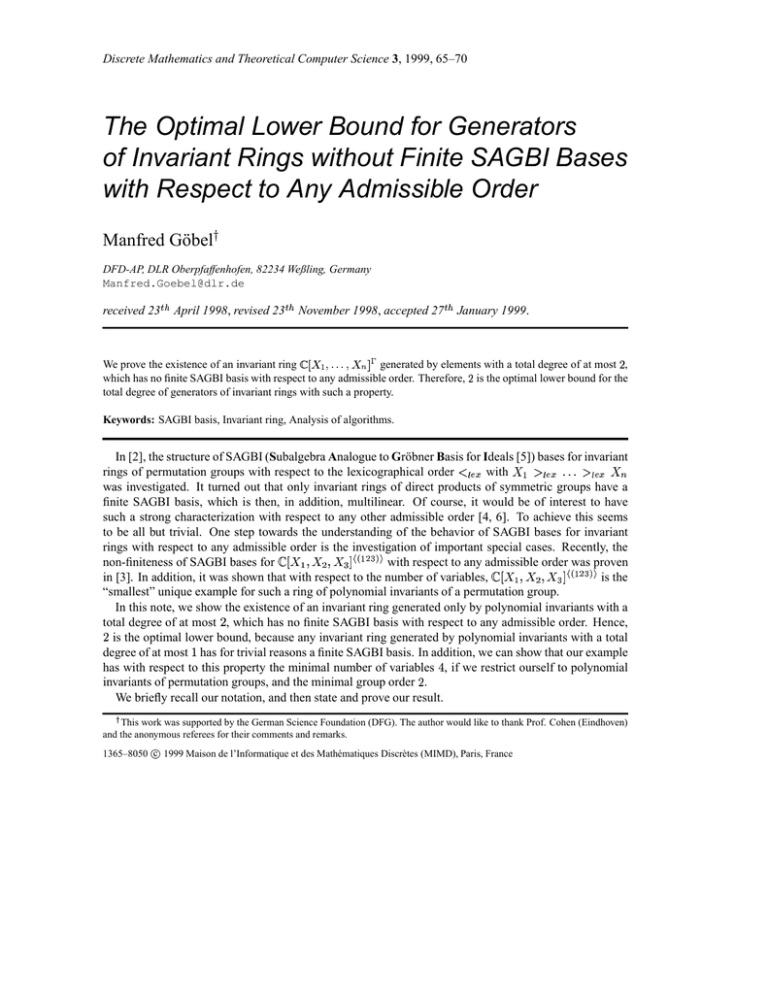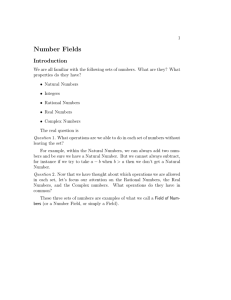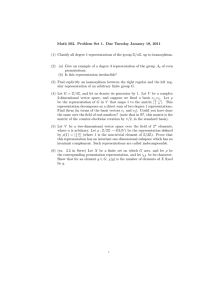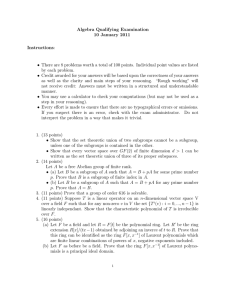The Optimal Lower Bound for Generators
advertisement

Discrete Mathematics and Theoretical Computer Science 3, 1999, 65–70
The Optimal Lower Bound for Generators
of Invariant Rings without Finite SAGBI Bases
with Respect to Any Admissible Order
Manfred Göbel
DFD-AP, DLR Oberpfaffenhofen, 82234 Weßling, Germany
Manfred.Goebel@dlr.de
received 23 April 1998, revised 23 November 1998, accepted 27 January 1999.
We prove the existence of an invariant ring generated by elements with a total degree of at most ,
which has no finite SAGBI basis with respect to any admissible order. Therefore, is the optimal lower bound for the
total degree of generators of invariant rings with such a property.
Keywords: SAGBI basis, Invariant ring, Analysis of algorithms.
In [2], the structure of SAGBI (Subalgebra Analogue to Gröbner Basis for Ideals [5]) bases for invariant
rings of permutation groups with respect to the lexicographical order with !"$#%#%#&!')(
was investigated. It turned out that only invariant rings of direct products of symmetric groups have a
finite SAGBI basis, which is then, in addition, multilinear. Of course, it would be of interest to have
such a strong characterization with respect to any other admissible order [4, 6]. To achieve this seems
to be all but trivial. One step towards the understanding of the behavior of SAGBI bases for invariant
rings with respect to any admissible order is the investigation of important special cases. Recently, the
/7089
non-finiteness of SAGBI bases for *,+ .- )/ - 1032546
with respect to any admissible order was proven
/089
in [3]. In addition, it was shown that with respect to the number of variables, *,+ :- )/ - )032546
is the
“smallest” unique example for such a ring of polynomial invariants of a permutation group.
In this note, we show the existence of an invariant ring generated only by polynomial invariants with a
total degree of at most ; , which has no finite SAGBI basis with respect to any admissible order. Hence,
; is the optimal lower bound, because any invariant ring generated by polynomial invariants with a total
degree of at most < has for trivial reasons a finite SAGBI basis. In addition, we can show that our example
has with respect to this property the minimal number of variables = , if we restrict ourself to polynomial
invariants of permutation groups, and the minimal group order ; .
We briefly recall our notation, and then state and prove our result.
>
This work was supported by the German Science Foundation (DFG). The author would like to thank Prof. Cohen (Eindhoven)
and the anonymous referees for their comments and remarks.
?
1365–8050 c 1999 Maison de l’Informatique et des Mathématiques Discrètes (MIMD), Paris, France
66
Manfred Göbel
@
The natural and complex numbers are denoted by A and * ,
@CB
@FE
+
D- #%#%# - is the set of terms (= power-products of the 1G ) in B
@CK,LNMB
@CK
@
is the commutative polynomial ring over B
( 2
and S
(
B
M
M
T P]\ Y^T
(
_
,
+ H - #I#%# - )(J2
(
_
RG)G - #%#I# -
.- #%#I# - _
M
T P
d
s
<Y
E
U
and
is the leading term of TU B
denotes its coefficient. A term s Y
M
Y
<:; P
Mc
. Then *,+ H
= PR
YQ
s
1/ -
(1)
-ROQP #
+
:- #%#I# - ( 2
, and
8Rz x{v
6ny
(2)
mW|
on the set of terms E is such that
s
N[
/
s
d -
s
-
/
E
U
with
s
s
N
+ 4/
625#
(3)
+ - #%#I# - )(
2 with respect to a given admissible order , and
7
is called multilinear iff D - #%#%# - :(^: - J
#%%
# #7 (
< .
T P
Lemma 1 Let K
K,LlMB
U'X$
}
Y
u:vWw7x
the X -invariant orbit of T . An admissible order
~<
Ggf P hiGkj f3hi(
b
denotes the B -algebra of X -invariant polynomials in B
( 2nm
m
s
M
(Gc1G Ped ZVY
G!`aQb
o:pqrts
EM
,
is called X -invariant, if
+ - #I#%# - )(W2
G!`aab
(
the symmetric group of O symbols.
T'Y[Z
+
, ..., a permutation group,
-ROQP
A polynomial TVU
The ring B
denotes the general linear group over B ,
-7OQP
K,LNMB
in the indeterminates / - -
M
T P
is generated by
0 - 1%2n
)/ - 10
- )0%
Proof A close look at the K -invariant orbits of *,+ H - / - 0
in [1] shows that we only have to find a representation of o:pqrts
/
and o:pqrts M P in terms of the elements of . We have
- (4)
)/3)0.W#
via the reduction technique described
/
/
o:pqrts
M
o:pqrts
M
0 P ,
0 P ,
1 P ,
- 1%2
/
M
o:p.qr5s
M
o:p.qr5s
M
o:p.qr5s
M
o:p.qr5s
M
/
0 P
1
/
0 P
/
:P
/
P
M
Y
M
Y
)0
M
Y
M
Y
M
)/ P
M
:P
)0
:P
/ P
)/3
10
M
)/ P
10
M
)/3
)03
:P
M
)/3
M
:P
M
)/ P
M
)/3)0 P
]
10
M
:P
)0
M
DP
)03
DP
/ )0
M
:P1/ P-
M
)/ P
:P-
and
1/ P-
with
0
M
/ 1Y
For any other non-multilinear special o:p.qr5s
0 - D,¡ , i.e. we can rewrite these orbits as
M
)/ P
M
M
0
o:pqrts
M
R
/
M
1 P
¢ 0
/
t 3¢ 0 P #
not listed so far, we have
P
0
P
- /
or
(5)
An Optimal Lower Bound for SAGBI Bases of Invariant Rings
or
M
This completes the proof of the lemma.
Lemma 2 Let
K
Y
M
Mc
<:; P
= PR
o:pqrts
0 1 P
M
/
0
67
%¢ 3¢
(6)
P #
£¤
. Then *,+ .- #I#%# - has no finite SAGBI basis with respect to
( 2
!
.
K
Proof The permutation group is not a direct product of symmetric groups. So, following [2],
*,+ - / - 0 - 132 can not have a finite SAGBI basis with respect to ! . £¤
Theorem 3 Let K Y¥ M <:;
any admissible order .
P
M
. Then
= PR
/ - *,+ - has no finite SAGBI basis with respect to
0 - 132
Proof Assume that *,+ - / - 0 - 132 has a finite SAGBI basis
with respect to , and assume
further w.l.o.g. that H¦ / , 0 ¦1 , and § 0 . Then we have either / ¦ 0 , or 0 ¦ / .
And further, the basis contains the multilinear K -invariant orbits
Q
/ - H
/ - 1
/
0 - 0
1 -
(7)
0 1J
and a finite number of non-multilinear K -invariant orbits of the form
¨
Rj lY[
R
"
/
R
0
(8)
¨
with §
Y
/©
< . Note that the leading term of
Y1
/ 0 is with respect to not determined
so far. Our goal is now to construct an infinite sequence of leading terms sª - s - s / - #%#I# of K -invariant orbits
such that almost all of these terms are not generated by products of leading terms of the polynomials in .
Let
sª
H1
s
s
GaY
G
EMo:pqrts
EMo:pqrts
/
, if sª Y® ,
otherwise. Furthermore, for
¢ IDG ¢ , and let
and let
ª
Y¬«
Y­1
G Y
R
<
«
/
7
7
0 P7P-
, if
, define s
/ Y¯
©
H
/
M
/ 0
"
0
R
-
¨
if EM P Y^H1
otherwise,
/
ª
Y® / 0 ,
EMo:pqrts
G Y
sª
if s G ¢ Y^
otherwise.
/
R
0
Y® / , if
Mks
G ¢ IDG ¢ PRP
sª
Y­
/
/ , and let
0
, and
ª
IGY¥DG ¢ Y
, if
¨
, we have s G is or / 0 with <F±¯.$¯ / , if EM P Y­1 , and with
~D/ ©
< , otherwise (see Figure 1 on the following page for an example sequence). The total degree
of s G is always smaller than the total degree of s G for r r /HUCA , and G is never a leading term of a
K
-invariant orbit for all r U'A .
Our selection of the G , r U'A ensures that the sequence of leading terms s ª - s .- s / - #%#I# in *,+ :- 1/ - )0 - has by construction the following properties: First, s G is never a product of terms in
For all
r
ª
r
/
P P 7
M
U°A
²
G ¢ Y~D
²
.- )/ -
EM ¨
P3- )0 - )0%
&³
s ª
- #%#%# -
s
G ¢
d
r
U'A#
(9)
Each product of terms in G ¢ matching the exponent of ()0 ) is unable to match simultaneously the
exponent of ()/ ), if s G Y ( / 0 ). Second, all other leading
terms in *,+ :- )/ - )0 - 2
²
EM ¨
s ª s
s
YI :- )/ have an expression as a product of terms in
P- 10 - )03 &³
- .- / - #%#I#´W#
2
68
Manfred Göbel
Altogether, this implies that any s G with a sufficiently large total degree has no expression as a product
of leading terms of the polynomials in the finite set . Hence, there exists no finite SAGBI basis of
*,+ - / - 0 - 132 with respect to (contradiction). £¤
Figure 1 illustrates the way of the sequence sª , s , s / , . . . thru the terms in question with respect to a
R
7
given admissible order . The upper (lower) half of the figure shows the first couple of ( / 0 )
/
sª
terms denoted by :## / ( # / # ) with µ[¶ / . We can see in this example that
Y·
0
/
/
/
0
/
ª
s
s
s
( Y¶1 ), FY¶ / 0 ( :FY¶ / 0 ), / Y¶
/ 0 ¸ ( /
Y¶ / 0 ), 0
Y¶ ¹ ( 0
Yº ¸ ),
²
/
/
s
s ª s
s
Y»I D- )/ - J- )0 - )03 ]³¼
( Y¦ ¸ ), and so on. The set
Y¦ ¸
- .- / - #I#%#´
1..2
1..3
2..3
1..4
2..4
3..4
1..5
2..5
3..5
4..5
1..6
2..6
3..6
4..6
5..6
1..7
2..7
3..7
4..7
5..7
6..7
1..8
2..8
3..8
4..8
5..8
6..8
7..8
1..9
2..9
3..9
4..9
5..9
6..9
7..9
8..9
1..10
2..10
3..10
4..10
5..10
6..10
7..10
8..10
9..10
1..11
2..11
3..11
4..11
5..11
6..11
7..11
8..11
9..11
10..11
1..12
2..12
3..12
4..12
5..12
6..12
7..12
8..12
9..12
10..12 11..12
1..13
2..13
3..13
4..13
5..13
6..13
7..13
8..13
9..13
10..13 11..13 12..13
1..14
2..14
3..14
4..14
5..14
6..14
7..14
8..14
9..14
10..14 11..14 12..14 13..14
... ... ... ... ... ... ... ... ... ... ... ... ... ...
...
.1 2.
.1 3.
.2 3.
.1 4.
.2 4.
.3 4.
.1 5.
.2 5.
.3 5.
.4 5.
.1 6.
.2 6.
.3 6.
.4 6.
.5 6.
.1 7.
.2 7.
.3 7.
.4 7.
.5 7.
.6 7.
.1 8.
.2 8.
.3 8.
.4 8.
.5 8.
.6 8.
.7 8.
.1 9.
.2 9.
.3 9.
.4 9.
.5 9.
.6 9.
.7 9.
.8 9.
.1 10.
.2 10.
.3 10.
.4 10.
.5 10.
.6 10.
.7 10.
.8 10.
.9 10.
.1 11.
.2 11.
.3 11.
.4 11.
.5 11.
.6 11.
.7 11.
.8 11.
.9 11.
.10 11.
.1 12.
.2 12.
.3 12.
.4 12.
.5 12.
.6 12.
.7 12.
.8 12.
.9 12.
.10 12.
.11 12.
.1 13.
.2 13.
.3 13.
.4 13.
.5 13.
.6 13.
.7 13.
.8 13.
.9 13.
.10 13.
.11 13.
.12 13.
.1 14.
.2 14.
.3 14.
.4 14.
.5 14.
.6 14.
.7 14.
.8 14.
.9 14.
.10 14.
.11 14.
.12 14.
.13 14.
... ... ... ... ... ... ... ... ... ... ... ... ... ...
Fig. 1: The leading term pattern for a given admissible order
½
.
separates the terms in the set D - / 0¿¾ 1À ¡:/ into leading terms (font: times-bold) and
other terms (font: times-roman) such that either or / 0 is a leading term, and such that any
²
other leading term in *,+ :- )/ - )0 - 2Á is a product of terms in .
The invariant ring *,+ - #%#I# - 1(W2nm is generated by polynomials with a total degree of at most < implies
that X is the trivial group, and that the generators are , . . . , 1( . Hence, ; is the smallest possible and
therefore optimal lower bound for the generators of an invariant ring without a finite SAGBI with respect
to any admissible order. Furthermore, we must have ¾ X ¾ © ; for any *,+ - #%#I# - )(W2nm with this property,
i.e. our example is minimal with respect to the group order, because ¾ K ¾ Y^; .
An Optimal Lower Bound for SAGBI Bases of Invariant Rings
Lemma 4 Let O
Then *,+ H - #I#%#
¡=
- 1(W2
69
, and let *,+ - #%#%# - )(
2 be generated by elements with a total degree of at most ; .
has a finite SAGBI basis.
Proof K is either SQ , SQÃÂ SQ , S / , SQÂÄS / , S / ÂÄSQ , or SaÃÂÄSQÂÄSQ , i.e. *,+ H - #I#%# - 1(W2 has a finite
SAGBI basis (Cf. [2]). £¤
Hence, *,+ - / - 0 - 132 with K YÅ M <D; P M = PR is, in addition, minimal with respect to the number
of variables, if we restrict ourself to polynomial invariants of permutation groups. Note that these results
hold not only for the field * but for any ring Æ , because our arguments are based on K -invariant orbits.
References
[1] M. Göbel, Computing Bases for Permutation-Invariant Polynomials, Journal of Symbolic Computation, 19, 285–291, 1995.
[2] M. Göbel, A Constructive Description of SAGBI Bases for Polynomial Invariants of Permutation
Groups. Journal of Symbolic Computation, 26, 261–272, 1998.
[3] M. Göbel, The “Smallest” Ring of Polynomial Invariants of a Permutation Group which has No
Finite SAGBI Bases w.r.t. Any Admissible Order, Theoretical Computer Science, to appear, 1998.
[4] L. Robbiano, Term Orderings on the Polynomial Ring, in: B. Caviness (ed.), European Conference
on Computer Algebra, EUROCAL’85, Proceedings Vol. 2: Research Contributions, volume 204 of
LNCS, Springer, Linz, Austria, 513–517, 1985.
[5] L. Robbiano and M. Sweedler, Subalgebra Bases, In: W. Bruns and A. Simis (eds.), Commutative
Algebra, Lect. Notes Math. 1430, Springer, 61–87, 1990.
[6] V. Weispfenning, Admissible Orders and Linear Forms, ACM SIGSAM Bulletin, 21:2, 16–18, 1987.
70
Manfred Göbel








